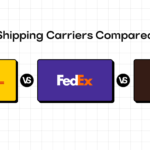In today’s e-commerce landscape, returns have become a huge deal. Recent research shows that the e-commerce return rate, which was 16% in 2022, now falls around somewhere between 20-30%.
Just like choosing what they want to buy, customers have been showing increasing involvement in sending it back (be it for any reason).
This has made how returns are handled at e-commerce stores a huge differentiator when it comes to customers choosing brands. 92% of shoppers say they will buy again if the return process is easy. In other words, if you meet customers’ high expectations from your returns process, you can treat yourself to loyal customers for life.
But what exactly are e-commerce returns, and how do you go about them? Well, all your answers lie here. In this article, we give you the complete rundown on e-commerce returns, from what they are and their process to the common challenges faced by businesses and some best practices. Keep reading to supercharge your e-commerce returns process!
Understanding E-commerce Returns
E-commerce returns are the digital age equivalent of buyer’s remorse, only with a shipping label attached. These involve customers sending back purchased items when they don’t meet their expectations (size-wise, color problems, issues with the material, the feel of the product, etc.) or because the customer simply changed their mind.
Unlike in physical stores, where returns involve a quick conversation at the counter, online returns are a bit more complex. They require a structured process involving return requests, approval or rejection, shipping logistics, inspections, restocking, and sometimes, a disappointed sigh from your finance team.
Returns are an inevitable part of e-commerce, with nearly 30% of all online purchases being sent back. This is significantly higher than in brick-and-mortar stores, where return rates are 8.89%. The reason? Online shoppers don’t have the luxury of trying before buying, making impulse purchases and sizing misjudgments are all too common.
From a business perspective, returns can be both an opportunity and a challenge. While they add to operational costs, a smooth and hassle-free return experience can boost customer loyalty and increase repeat purchases.
The key to managing e-commerce returns successfully lies in setting clear return policies, offering flexible options like exchanges or store credit, keeping customers informed, and leveraging technology to automate and streamline the process. The goal? Minimize losses while maximizing customer experience.
Returns are not just about getting products back; they’re about ensuring customers come back too. Get it right, and you turn a refund into a future purchase. Get it wrong, and you might just find your brand featured in an X rant.
Steps involved in the return process
While the returns process can vary with e-commerce businesses and their unique returns policies, here’s a look at the typical steps involved. As we mentioned previously, it all starts from the moment the customer wants to initiate a return.
1. Customer requests a return on their order
Returns happen for a lot of reasons, some of which have no logical explanation and are simply based on the customer’s emotions.
But in this case, let’s take the example of the customer being unhappy with their order. The customer selects the item they wish to return along with a valid reason (as you requested).
2. The return request is rejected or approved from your end
When return requests do not meet the conditions you’ve provided, the return request can be rejected and interaction with the customers for this particular order ends here.
On the other hand, if the reason for the return is valid it can be approved from your end and the process for initiating the return gets started.
3. When the order return is in transit
Order returns are in transit from the moment it is scheduled to be collected to the moment it reaches back to your store. These moments are usually leveraged by e-commerce brands to share return status updates.
4. When the product is returned to the store
Once the product makes its way back to your store, you can start collecting the customers’ feedback on their shopping experience with your brand. If the feedback is positive, you can also try convincing the customer to shop for a replacement (if they hadn’t chosen one already).
That’s all from the experience front. In terms of business operations, the product is then sent for inspection. If there’s no sign of damage, the product is re-stocked in the inventory and sold to another customer.
Now that we’ve got a better context, let’s discuss some of the challenges related to returns management that you must keep your antennas up for.
Challenges Faced by E-commerce Businesses
Customers only gravitate to online stores that have easy return procedures. Handling returns is often easier said than done because it involves a variety of challenges. Here’s a look at these:
- Interrupted warehouse efficiency: Unexpected return of goods can complicate warehouse operations and inventory management. Per-process handling costs can escalate, and this, combined with resale challenges, can become a major pain point.
- Extreme return policies: Some businesses have strict return policies to combat the increasing number of returns. However, customers only respond to and become loyal to brands that have flexible return policies.
- Handling product damage: Once products are brought back to the warehouse, they have to be conditioned for resale. Most business owners ask customers what was wrong with the product but “It was damaged” is not an answer to work with. Figuring out the problem with a damaged product can consume a lot of time and money.
· Loss of liquidation: Sometimes, you might want to liquidate an entire set of products if there is a continuous return from that category. For instance, the previous season’s clothes, old electronics, etc. This might lead to selling them at prices far below the retail price.
How to Overcome E-commerce Return Challenges
While there are myriad challenges associated with reverse logistics, thankfully, there are a variety of ways by which these can be overcome. Here’s a look at these:
- Use technology to your advantage: Returns come with a lot of supply chain confusion and losses. One way to reduce these is by streamlining back-office operations and integrating them with the overall reporting system. This will help you identify the exact threshold to cross for a customer to become problematic. Addressing problems according to individual customer profiles can help you reduce costs. For instance, beauty and cosmetics giant Sephora used this technique to identify clients who returned their products several times, mostly after trying them out. They imposed a rule that their products couldn’t be returned more than twice in any given situation. This is a well-balanced return policy that is fair to the brand and the customers.
- Use the data on hand: Collect all the important data associated with the return of goods. The number of returns for a particular product type, the type of damage, and the number of returns due to improper packaging are significant actionable data. Having this data on hand will help you improve your packaging and delivery efficiency and also aid decisions pertaining to restocking products. You can use tools like Optoro to carry out the data analysis process.
- Pre-print return labels: Protect your business from fraudulent returns. Attach pre-printed return labels that include invoice numbers, quantities, and SKUs. When products are returned with these return labels, your team will know the returns are authentic. They will then be able to proceed with the replacement process.
- Offer a reasonable return time limit: The time within which customers can return products is critical. Usually, small businesses have a 60-day return policy, but depending on the products you sell, set a reasonable return time limit that does not affect your business or is too little of a time window for customers. If you are selling perishable goods or products that have a short shelf life, you can fix a 30-day or 15-day return policy.
- Create a balanced return policy: Creating a balanced return policy that does not affect your business is essential. However, make sure this policy is flexible when it comes to retaining loyal customers. As a small business, you can bend backward to maintain your loyal customers. You can also ease out the return process by adding a small gift like a discount voucher, as an apology for a damaged product or even have a follow-up call to ask about the replaced products. If you rack up overhead expenses due to these measures, you can always take loans for your retail business.
Best Practices for Managing Returns
Now that you know what e-commerce returns are, what they entail, and most importantly, the challenges that come with them, it’s time to discuss what steps you can take to make your returns process as seamless as possible, driving both your customer experience and revenue. Let’s dive in!
1. Have a shopper-friendly returns policy
67% of shoppers check the returns policy before making a purchase
The first thing a shopper checks when wanting to return an item is your store’s return policy. Therefore, make it friendly enough to attract them and encourage repeat shopping.
The best ploy with a returns policy is:
- Making it flexible enough in terms of conditions and deadlines
- Having it mention your objectives and the customers’ needs clearly
- Not encouraging fraudulent returns and wardrobing
This way, there is a win-win situation, and you can still manage to increase conversions without spending too much on acquisition and other unwanted return-related expenses.
Also, make sure your returns policy is easy to find for the customer and display it in areas of clear visibility such as the home page, product pages, checkout page, FAQ section, etc.
2. Promise a hassle-free returns experience
Your customers return their purchase because they were unhappy with something around it, such as fitting, color, damages, etc. They have been excited to get the product on their hands the second they hit ‘buy’. Therefore, mitigate their frustrations by making your returns process seamless.
You can take the hassle out of product returns by enabling your customers to initiate returns directly from the order tracking page instead of spending time searching for it. This helps in improving the return experience and in turn, delights your customers.
You can also extend the seamless returns experience by enabling the customers to print automated and prepaid return labels and get done with their order returns quickly.
3. Make the returns process fast and easy for your customers
92% of shoppers say they will buy again if the returns process is easy.
Apart from prepaid return labels, you can also enable customers to initiate returns easily and fast with the help of a returns portal.
Your customers can pull up their orders, select the item they would like to return, provide a reason, select the return method, and voila! Get their returns initiated in less than a few minutes.
Such an experience would give your customers all the more reason to keep shopping with you.
4. Keep your customers in the loop of their returns
Just like order delivery, your customers would like to stay in the know of their return status as well.
Look forward to sending proactive updates on return requests, via automated email and SMS notifications and providing a tracking page that provides complete transparency around return status.
This can keep your customers in the loop effortlessly and eliminate their anxiety about the whereabouts of their returning package.
5. Get smart with your returns
70% of all returns are size and fitting related.
Imagine refunding all these returns and taking a hit on your profit margins amidst the already sky-rocketing shipping costs.
Now, this is where you can get smart with your returns and encourage customers to opt for alternative and efficient return methods such as exchanges or store credits options to ensure revenue retention for your e-commerce business.
You can incentivize your customers to choose these alternatives with prepaid labels, free shipping, bonus credit, etc, and increased revenue retained.
6. Automate your returns management process
25% of e-commerce sites don’t support non-product search queries, like returns or tracking.
This can lead your customers to bombard your support reps and turn out to be tedious for your support team as well as expensive for your business.
You can consider making your returns management process self-service by automating them to prevent such problems.
Automating your returns process can help you:
- Free up your support agents to address more pressing issues
- Drastically reduce time spent per return request and inbound conversation volume.
Reducing Ecommerce Returns
Managing your e-commerce returns and streamlining the process to drive your customer experience and, by extension, revenue doesn’t have to be a grueling process. All you need to do is onboard a Returns Experience Management (REM) platform.
And the good news? You have the best one right here at LateShipment.com. LateShipment.com’s solution helps e-commerce businesses take delight beyond the buy button with seamless, flexible returns in the form of:
- Provisions to set up flexible return methods and automated, prepaid labels
- A customizable, on-demand return portal with zero interaction with support agents to make the return experience fast and easy for customers
- Proactive updates on return requests via automated email and SMS status notifications to keep customers in the loop effortlessly
- A live tracking page to provide transparency around return status and eliminate customer anxiety about the whereabouts of their package
- Offer seamless exchange and store credit options to ensure revenue retention
- Support user and warehouse operator dashboards are purpose-built to drive quick return request resolution
- Proactive, automated status updates ensure your customers have complete transparency on return status at all times, thereby reducing ticket volume
- Returns trend analysis and insights such as return satisfaction scores to keep track and make constant improvements to provide the best return experience there is
And boost returns-related metrics that matter most to your business via increasing conversion rate, repeat purchases, revenue retained, etc, and reduce time spent per return.
By using REM, e-commerce businesses can improve the returns process and increase customer satisfaction, leading to improved customer loyalty, increased sales, and ultimately a better bottom line.
If you’re wondering what onboarding at REM looks like on the ground. Here are some convenient use cases that give you a peek into how a returns management solution can drive your returns experience:
1. Offer shoppers a simple and seamless return experience
Operations & Marketing teams have forever struggled to deal with customers who feel the returns process is difficult, time-consuming, and frustrating.
With no REM in place, customers have the need to contact the support team whenever there’s a need to return or exchange products. More often than not, this frustrates customers who are already irate over having to return something that they’ve longed enough to buy (all the more pressure for merchants during times like the holiday season when gifts hold higher emotional value).
The solution is really simple: your customers are not looking forward to doing returns, so why make the process even more frustrating for them?
With a REM in place, you make returns and exchanges self-service to shoppers via a dedicated returns portal that enables easy initiation and automated label generation, thereby eliminating the need for customers to contact the support team each time.
2. Reduce inquiries from anxious customers about the status of their returns and refunds.
Customer support teams are bombarded with an influx of inquiries from concerned customers about the status of their returns and refunds.
Just like the order delivery process, customers expect the business to stay in the know of their return’s status at all times and become increasingly anxious when they’re left in the dark regarding it.
In normal cases, this affects the returns experience of the customers by making them constantly go to the shipping carrier’s website to check the return status. In extreme cases, this can lead to anxious customers bombarding your support team with a return status inquiry that can consume all of their time.
Here’s the solution. REM helps businesses send automated return status updates to customers with the ability to track their returns in real-time. By mitigating customers’ anxiety via regular and timely engagement, businesses can reduce return-related customer inquiries by up to 80%.
3. Retain sales and revenue with returns
In a typical environment, returns typically result in refunds, hence losing sales and profits.
According to a recent report, 70% of all returns are size and fit related. That’s almost three-fourths of your returns that don’t have to mean a refund.
However, with a lack of REM in place, Returns typically result in refunds, where the business has to refund the customer for the purchase price of the product, as well as the cost of shipping the product back to the business. In addition, the business may have to pay a restocking fee, which is a fee that is charged to customers who return products.
Instead of refunding every return, REM provides businesses the chance to get smart with returns via flexible return methods.
By offering seamless exchange and store credit options, businesses can:
- Keep customers shopping with the business despite an order return in place
- Provide a great returns experience and ensure that customers are more likely to spend more money with the business
- Reduce return-associated costs such as refunds and other processing costs and retain revenue from over 30% of your returns
To ensure that this process yields more successful results, businesses can also incentivize customers to opt for exchange or store credit with prepaid labels, free shipping, and bonus credit.
4. Automate and streamline the return process to reduce operational time
Return processes that heavily rely on assistance from support teams make returns unmanageable and time-consuming.
It’s not just initiation, customers’ doubts about returns begin the moment they have a return requirement and repeatedly check the returns page to understand more about the company’s policies with returns.
One of the main reasons for this happening is that the returns get handled differently from brand to brand and when things are unclear, customers do have a hard time understanding if their product does qualify for a return. This often leads to the need for human intervention at every step, which creates a bottleneck by straining resources and frustrating customers who expect quick and efficient resolutions.
This is where REM comes in to help businesses transform their return experience by automating the return process via presetting and customizing return rules and policies, auto-generating return labels, etc, and ultimately reducing return processing time by up to 90%.
5. Gain visibility into the when, the where, and the how the return progresses
Warehouse operators and the operations team are unable to effectively track returns in real-time, making it a hassle to maintain accurate return inventory records and streamline the overall returns process.
Most businesses view returns as something complicated because they lack sufficient insights into what’s going wrong in the first place, thereby having no room to make necessary improvements and streamline the overall returns process.
Returns Experience Management, built to boost return-related metrics that matter most to businesses, comes with the ability to break down returns in order to gain visibility into the exact status, condition, and location of every return, i.e. anything related to the product being returned.
By breaking down returns into simple, actionable metrics, you can easily keep track, make better business decisions to turn these metrics to work in your favor, and ultimately spell the success of your e-commerce business’ returns strategies.
6. Optimize return operations and drive strategic process improvements with actionable insights into returns
There is a lack of true visibility into their return operations and inefficiencies to make necessary improvements.
Under normal circumstances, handling multiple returns can really be overwhelming, particularly during times like peak shopping seasons.
Rather than going in blindly, it is better for businesses to get complete visibility into how your returns are performing via actionable insights, particularly through analyzing return trends, such as the types of products frequently returned, reasons for returns, etc, and identifying root causes to drive improvements to your returns process and experience.
For instance, if a specific product category consistently experiences high returns, the business can scrutinize its quality, sizing information, or imagery to address underlying issues. Armed with this data, companies can refine product descriptions and enhance quality control.
Embracing these insights enables e-commerce businesses to gain absolute visibility & control to measure and optimize the entire return operations.
Conclusion
No e-commerce business wants returns to be a highlight for their business, but ignore it, and you’re opening doors to compromised customer experience, negative reviews, and reduced revenue. Handle it well and you make a frustrating process an opportunity.
Further, with the right approach—smart policies, seamless automation, and a touch of customer empathy—you can transform returns from a revenue drainer into a customer retention strategy. After all, a smooth return today could mean a loyal customer tomorrow (or at least one less negative review).
But why do all the heavy lifting yourself? Enter LateShipment.com’s Returns Experience Management (REM) platform—a game-changer for e-commerce brands looking to simplify returns, retain revenue, and keep customers happy.
From automating returns to providing real-time tracking and insights, LateShipment.com ensures that every return is handled effortlessly, leaving both you and your customers smiling. Because let’s be honest—returns should be painless for everyone involved.








